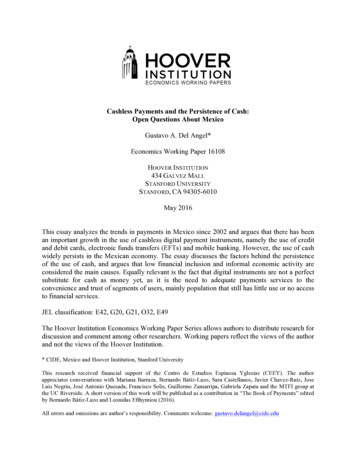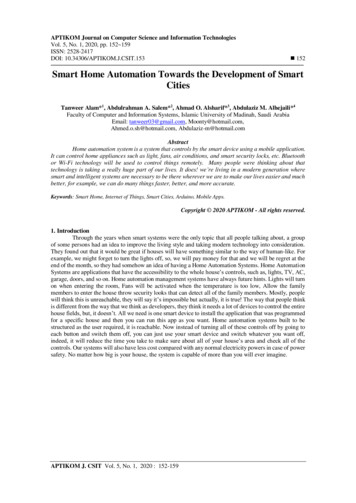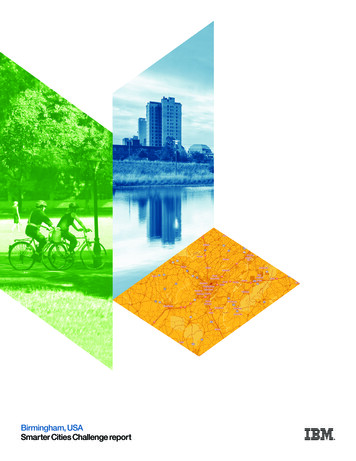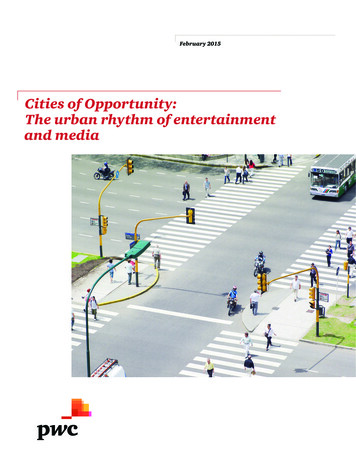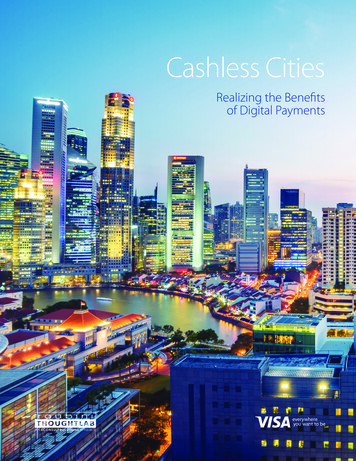
Transcription
Cashless CitiesRealizing the Benefitsof Digital Payments
About Roubini ThoughtLabAbout VisaRoubini ThoughtLab is a research firmbased in New York City that providesmanagement thinking and evidencebased analysis to help corporate, financial,and government leaders cope withtransformative change. Our clients includepremier global consulting, financial, andtechnology companies and not-for-profitorganizations. By applying advancedmodeling tools, in-depth qualitativeresearch, and high-level expert opinions,our firm offers actionable insights intoindustry, economic, and technologytrends and their impact on the world.Visa Inc. (NYSE: V) is a global paymentstechnology company that connectsconsumers, businesses, financialinstitutions, and governments in morethan 200 countries/regions andterritories to fast, secure and reliableelectronic payments. We operate oneof the world’s most advancedprocessing networks — VisaNet — thatis capable of handling more than65,000 trans-action messages a second,with fraud protection for consumersand assured payment for merchants.Visa is not a bank and does not issuecards, extend credit or set rates andfees for consumers. Visa’s innovations,however, enable its financial institutioncustomers to offer consumers morechoices: pay now with debit, pay aheadwith prepaid or pay later with creditproducts. For more information, visithttps://usa.visa.com/ and @VisaNews.Roubini ThoughtLab is a joint venturewith Econsult Solutions Inc., a leadingeconomics consultancy. With access toa global team of over 100 economists,industry analysts, and urban experts, ourfirm brings together macro-to-microanalytics with the ability to survey andinterview executives, consumers, and policy-makers around the world. We provideour analysis in a variety of engagingexecutive formats, from global rankingand benchmarking tools to cost-benefitand economic impact models.Visa’s Global Public Policy group,established in 2015, commissioned thisstudy. The group’s mission is to informpublic policy dialogue globally throughthought leadership.Terms of referenceThis study quantifies the benefits associated with use of digital payments. In doing so, costs and benefits of various payment methods were assessed. This report covers 100 cities from across80 countries/regions. The net benefit figures for the 100 cities covered in this study are approximations based on a combination of primary survey data gathered from across a sample of sixrepresentative cities globally (please refer to the Technical Appendix for more details), and secondary data from well-recognized organizations such as the World Bank, Organization forEconomic Cooperation and Development (OECD) Union Internationale des Transports Publics (UITP), and McKinsey and Company. The numbers in this report are quoted in US Dollarsand generally pertain to averages across the 100 cities, unless otherwise stated. Some benefits of digital payments (e.g. increased convenience, personalized services, improved expensetracking and efficient inventory management) and costs of cash payments (e.g. health and environmental impacts) are difficult to quantify and are not within the scope of this research. For amore detailed note on the costs and benefits, please refer to the Technical Appendix. Therefore, the digital payments net benefit figures presented are a conservative estimate. While the reportprovides net benefit estimates for three main stakeholder segments (consumers, businesses and governments), it does not make a distinction within these segments. As such, the benefits arenot broken down based on different types of businesses, consumers and levels of government. Specifically, estimates for government benefits are based on city-level data. However, fiscalarrangements among different levels of government in each country will determine how these benefits get distributed. It is also important to recognize that as payment service providers,financial institutions both benefit and incur significant costs associated with supporting different forms of payment methods. This study does not consider costs and benefits to financialinstitutions since such data is commercially sensitive and not readily available. The catalytic impact (GDP, employment, wages, and productivity) estimates are provided for the 15-year horizonfrom 2017-2032. Estimates are based on average annual growth over the projected 15-year period, unless otherwise stated. These estimates are derived using the National Institute GlobalEconometric Model (NiGEM), which provides a 15-year forecast. The report makes reference to “physical money” and “digital payments”. “Physical Money” in this report includes cash, checks andmoney orders while “digital payments” includes debit cards, credit cards, prepaid and/or stored-value cards, online/mobile electronic bill payments, mobile money/e-wallettransactions, and bank wire transfers. All references to data that aren’t linked to another source are direct findings from this study. Please refer to the Technical appendix for additional detailsabout the methodology.
Cashless Cities:Realizing the Benefitsof Digital Payments
Table of Contents
Executive Summary11. Introduction62. The High Cost of Cash143. Net Direct Benefits of Moving Toward Cashless183.1 Consumers193.2 Businesses263.3 Governments304. Catalytic Impacts365. Barriers & Action Roadmap406. Conclusions487. 100 City Impact Data50Appendix: Endnotes54
Executive Summary
Cities account for a large proportion ofthe global population and its economicactivity. Today, over half of the worldpopulation lives in cities1. By 2050, thisnumber will increase to two-thirds2.Currently, over 80% of global economicactivity takes place in cities and it isexpected that the vast majority of futureeconomic growth will come from cities3.With such a significant share of a country’s populationand economic output concentrated in its cities, there is animmense opportunity to further increase economic growthand improve quality of life for billions of people.In recognition of this opportunity, a number of cities globally have introduced smart city initiatives, and are utilizinga wide range of digital technologies to improve the livesof their residents. Smart city initiatives and supportingpolicies could potentially become critical pathways forgovernments seeking to foster economic growth, improvesafety, attract businesses and provide better services totheir citizens. Digital payments technology is a crucialenabler of smart cities, and could contribute significantbenefits to consumers, businesses, governments andeconomies. Since digital payments are a means to an end,the scale of benefit they bring has not been broadly understood or studied.This study is unique in that for the first time it looks at the netbenefits associated with adopting digital payments and doesso at the city-level. The assessment is carried out for 100 citiesacross 80 countries/regions, segmented by stage of digitalmaturity, with these cities modelled to an “achievable cashlessscenario”. This scenario is defined as the entire populationmoving to digital payment usage equal to the top 10% of theusers in that city today. The findings provide compellingsupport for greater adoption of digital payments.This study estimates that increasing digital paymentsacross the 100 cities could result in total direct net benefitsof US 470 billion per year. On average, these net benefitsrepresent slightly over 3% of a city’s current GDP. Greatereconomic activity spurred by digital payments alsosupports higher employment as well as improvements inwages and workers’ productivity. This study also finds thaton average, across the 100 cities, increased usage of digitalpayments could add 19 basis points to a city’s GDP andsupport over 45,000 additional jobs per year per city, whileworker productivity and wages could increase by 14 and16 basis points per year per city, respectively. To put theGDP growth number in perspective, the 19 basis pointsincrease in economic growth per year across the 100 citiestranslates to nearly 12 trillion of total additional economicactivity over the next 15 years – an amount exceedingChina’s 2016 GDP.Major findings from the analysis contained in this studyinclude: Consumers across the 100 cities currently spend anaverage of 32 hours a year – nearly a full work week on cash-related payment activities. Greater adoptionof digital payments is estimated to reduce this figureto 24 hours a year, saving consumers in the 100 citiesan average of over 126 million per year. When otherbenefits of digital payments are taken into account,1
Cities analyzed in this study,categorized according to theirlevels of digital DNEW YORK CITYSAN FRANCISCOWASHINGTON EXICO CITYSAN JUANSANTO DOMINGOKINGSTONSAN JOSEPANAMA CITYCARACASACCRALAGOSBOGOTALUANDALIMABRASILIASAO PAULOSANTIAGOMONTEVIDEOBUENOS AIRESReferences:Cash Centric21Digitally Transitioning2Digitally MaturingCashless Cities: Realizing the Benefits of Digital Payments
HELSINKISAINT ENSTEHRANOSAKATOKYOBEIRUTCAIROTEL AVIVKUWAIT ENDHAKAMUSCATHANOIMUMBAIBANGALORETAIPEIHONG KONGCHENNAIBANGKOKMANILAPHNOM PENHCOLOMBOKUALA BANSYDNEYCANBERRAAUCKLAND3Digitally AdvancedCashless Cities: Realizing the Benefits of Digital Payments4Digital Leader53
5.00%- 304.00%- 25- 203.00%- 152.00%- 101.00%such as reduction in cash-related crime, these savingscould increase to 278 million per city, equivalent toabout 67 per adult per year.GDP growth in basis pointsNet direct impacts as percentage of GDPGraph of average net benefits Accepting cash and checks costs businesses about7 cents of every dollar received compared to 5cents for every dollar collected from digital sources.When combining savings with increased sales fromdigital payments usage, our study projects thattotal net benefits to businesses across all 100 citiescould amount to over 312 billion per year aftertransitioning to an achievable level of cashless activity. Average annual savings to governments in directadministrative expenditures by making greateruse of digital payments amounts to 710 million.A reduction in cash-related crime could save anadditional 53 million per year. Meanwhile, theestimated potential increase in tax revenue fromdigital payment adoption amounts to an average of 534 million per year. As shown in Figure 1, cities at every level of digitalpayments maturity could benefit when moving fromcash to digital entricConsumerGovernmentBasis points increase in average GDP growth (2017 - 2032)Figure 1: Cities in each maturitycategory stand to benefit fromgreater adoption of digitalpayments.Source: Roubini ThoughtLabModel and AnalysisFor this study, Roubini ThoughtLab researchers firstsurveyed consumers and businesses4 located in six citiesrepresenting five different stages of digital paymentmaturity. Survey results were extrapolated to an additional94 cities (See pages 2-3) using supplemental data from theWorld Bank, OECD, and other secondary data sources. The100 cities studied represent 80 countries/regions. The netdirect benefits presented in this study are based on this100 cities analysis under an achievable cashless scenario.The National Institute Global Econometric Model (NiGEM)was then used to determine catalytic economic effects.Finally, this study identifies several high-level barriers to a city’ssuccessful transition to digital payments. These are matchedto an Action Roadmap directed at policy-makers, consumersand industry participants, aimed at overcoming thesehighlighted barriers. These actions are offered as an indicativeguide for stakeholders to consider.4Cashless Cities: Realizing the Benefits of Digital Payments
Overall BenefitsGreater levels of cashlessness generate positive net benefits for citiesTop 10%of digitalpaymentadoptersCurrentaverage usageAchievablecashlessnessA selection of benefits if cities moved to achievable levels of cashlessnessConsumerBusinessGovernmentSavings from more efficient government processesIncreased tax revenues from recaptured informal economyIncreased tax revenues from greater business salesCriminal justice costs savings from reduced crimeToll-road and transit agency cost savingsBetter data on citizen needsLower costs of managing cashSmart cities to enhance quality of life for citizensReduced theft and pilferageLabor time savingsSavings from reduced float times and costsPotential for greater sales through digital channelsBetter data to improve customer serviceLeverage data for targeted promotional campaignsConvenient inventory and expense trackingUtilize data to improve loyalty schemesTime savings in banking, transit and retail transactionsFloat savingsSavings from avoidance of late payment feesSavings from reduced crimeIncreased convenienceImproved budgeting and expense trackingMore personalized customer serviceBetter data to build credit profilesPotential net direct benefits across 100 cities per year for payments industry stakeholdersTotalnet benefits 470billion#Total consumer net benefits 28Total business net benefitsTotal government net benefits 312billion 130billionbillion# This translates to an average of 3.08% of GDP per cityEconomic impacts for 100 cities when moving to achievablelevels of cashlessness over 15 years (2017-2032)Totaladditionaleconomic activity* 12trillionGDP19average annual basispoint increaseEmployment5million jobssupported over 15 yearsProductivityWages0.14% 0.16%increase inbaseline CAGRincrease inbaseline CAGR*Between 2017 and 2032CAGR: Compound Annual Growth RateCashless Cities: Realizing the Benefits of Digital Payments5
1. Introduction
Policymakers around the world areincreasingly focused on the economicand social development of major urbanareas. This attention is due to severalreasons. First, the world’s population isincreasingly located in urban centers.According to the UN, 60% of the globalpopulation is expected to be living incities by 2030, up from only 30% in 1950.5Second, large urban centers are engines of economicgrowth for the entire country in which they are located.For example, São Paulo, which is home to approximatelyten percent of Brazil’s total population, accounts forroughly a fifth of the country’s total economic output asmeasured by GDP.6 Moreover due to a concentration ofresidents and businesses, economic initiatives that startin major urban centers can often be expanded moreeffi-ciently to smaller cities and rural areas based onexisting economies of scale. Large urban areas can actas an incu-bator for initiatives that can eventuallybenefit a country’s entire population.Finally, perhaps because of the economic impact citieshave on a nation’s economy and certainly due to theenhanced mobility of both labor and capital in today’sincreasingly connected economy, large global citiescompete with one another for business headquarters,manufacturing facilities, transportation hubs, educatedprofessionals, arts and entertainment events, andinternational tourism. Municipal governments routinelyoffer tax, land use, and other incentives in an attempt toattract such economic activity. At the same time, globalcorporations and even top-tier professionals routinely“shop around” for the most advantageous investmentdestination or home.Cashless Cities: Realizing the Benefits of Digital PaymentsTo fully realize their potential impact, cities across theworld are undertaking “smart city” initiatives.7 Generally,smart cities are defined as those with ubiquitous digitaltechnologies that aim to improve city living, promotecommerce, and drive economic growth, ultimatelyattracting more business investment, residents and visitors.While the specifics of each city’s smart city strategy vary,common core elements tend to include public Wi-Fi, highspeed broadband connectivity for key urban zones, trafficcontrol systems, and extensive use of digital payments.The next wave of technologies—the Internet of Things,driverless cars, wearables, robotics, blockchain, biometrics,and artificial intelligence, to name just a few — may fueleven greater investments in smart city initiatives. Gartner,a research firm, predicts that the Internet of Things willconnect 20.4 billion devices by 20208, about three timesthe number of people in the world.This paper is focused on the digital payments componentof cities’ smart strategies. The reality in cities around theglobe is that more and more people are adopting digitalpayments and “cashing out” in their daily lives. A cashlesssociety, says Michael Busk-Jepsen of the Danish BankersAssociation, “is no longer an illusion but a vision that canbe fulfilled in a reasonable time frame.”9 Some believe7
Stagesof DigitalMaturityMaturity Levels12Cash CentricDigitally TransitioningPrimarily citiesfrom Africa (7 cities)and Latin AmericaCompositionPrimarily composedof cities from LatinAmerica, Middle East,Russia, and IndiaLagosRepresentative nessLow rutBuenos laMexico CityMonterreyPanama CityPhnom PenhSanto oreBucharestCaracasChennaiColomboDelhiLow yadhSaint PetersburgSantiagoSan JoseSan Juan
345Digitally MaturingDigitally AdvancedComposed bymore advancedcities in Asia, Europe,and the U.S.Mostly composedof cities from Asia Pacific(9 cities – driven byChina and SoutheastAsian countries)São Paulo / TokyoSao PauloEuropean, Canadianand Australian citiesthat have the mostadvanced digitalpayment usageChicagoStockholmTokyoLowHighreadiness, unbankedhigh usage aDubaiDurbanJohannesburgDigital LeaderHighCulturalreadiness, inclinationlow usage toward cashKuala LumpurKuwait ranTianjinUlaanbaatarWarsawZurichDeveloped digitalinfrastructure, but maintainsconsiderable cash ow levelsof unbankedpopulationFrankfurtHong KongMadridNew York CityOsloParisSan FranciscoSeoulSingaporeTel AvivViennaWashington, DCDeveloped bankingand digital paymentsystemAucklandCanberraCopenhagenHigh early fullybankedSydneyToronto
they will eventually be living in a cashless society. A recentsurvey in the U.K., showed that a majority of respondents(68% of the 2,000 surveyed) believe that cash will nolonger exist within 20 years. Surveys in other countries/regions have shown similar results.10With the pace of this digital change accelerating aroundthe world, national and municipal governments areembracing smart technology and cashless payment solutions. For example, Bucharest recently installed contactless payment terminals in all of its metro stations.11 TheBank of Korea announced in December 2016 that it plansto eliminate physical coins by 2020, a first step towardmaking South Korea a cashless society.12 Dubai is developing the use of smart receipts – digital receipts that canbe directly stored in a mobile device - that will replacepaper and email receipts to enhance transparency inretailing, boost consumer confidence, and improvepersonal financial management.13Business leaders are also responding to consumer expectations and contributing to a more cashless future. Forexample, Sa
than 200 countries/regions and territories to fast, secure and reliable electronic payments. We operate one of the world’s most advanced processing networks — VisaNet — that is capable of handling more than 65,000 trans-action messages a second, with fraud protection for consumers and assured payment for


